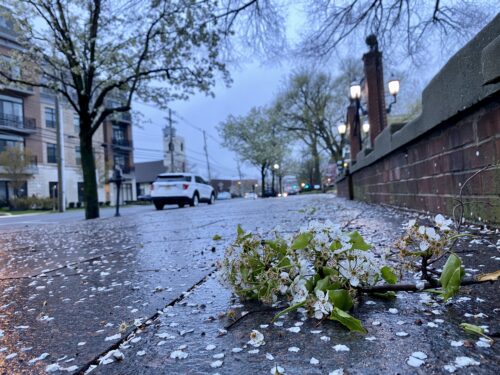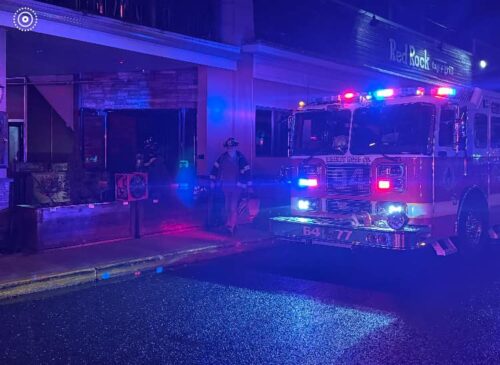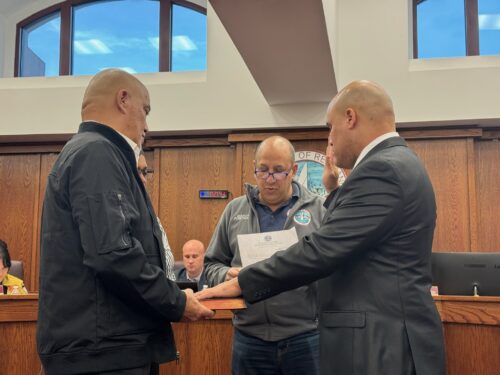
By JOHN T. WARD

Along the way, the place seems to have acquired a non-paying tenant, in the form of a generally benign if somewhat mischievous ghost named Mrs. Roberta Patterson.

Roberta, it seems, did not have appreciated McMahon’s “constant discussion of the details of her family’s life,” Heyer speculates.
Hubris, payback and just plain eeriness abound in Heyer’s book, her first. There’s the story of a Middletown man who created a zoo at his farm, only to have a large grey wolf in his collection wreak havoc on his family. There’s the tale of Navesink man who gets a comeuppance for shooting an aged seaman in a fit of rage over his precious oyster beds. A gun gets fired at a ghost haunting the Greek Club above a Broad Street store, but no damage results, even though the spent bullet lies distorted, as though it had struck something.
Each tale, the author writes in an introduction, “is based upon actual events or a series of events from local history.” The story of the wolf, for example, contains references to specific dates, and cites the involvement of Red Bank photographer and cinematographer Dan Dorn.
Elsewhere, there’s the occasional attribution, often to contemporaneous newspaper accounts, but Heyer said she took liberties in creating dialogue and describing scenes. In a chapter titled “Beyond the Veil: A Victorian Ghost Party,” she describes in rapturous detail the costumes worn by guests at a party thrown by a widow of a man killed at the Battle of Gettysburg.
Heyer calls the book “a collision of history and folklore [that] creates savory reading.”
A perennial student who has taken classes in veterinary science, oceanography and funeral work, Heyer said she’s always loved learning and writing. She grew up in rural Ringold, Pennsylvania (population: 210) , where she began writing — one of her English teachers was Chuck Daly, who later become coach of the New York Knicks (“He was petrifying,” she said). After graduating from Slippery Rock State College (now university), she was recruited to teach in the Red Bank public schools.
During her 34 years in the district, which ended with her 2001 retirement, Heyer taught special education, but discovered immediately that there was little if any material tailored for the kids.
“I had eighth-grade boys at River Street School who couldn’t read,” she said. “They didn’t want to read about Dick and Jane and ‘See Spot Run.’ So I had to write for them.” Heyer said she’d rewrite standard history at a level the students could grasp. “It was either that, or having kids not connect,” she said.
Her creativity led, in turn, to about a decade of freelance “package writing,” fiction and nonfiction commissioned by textbook publishers for use as support learning materials in classrooms.
She’s “not particularly” into ghost stories, Heyer said, but her husband, Bob, loves ghost movies, which she said she “tolerates.” It was Bob, however, who came upon the loose thread that became the story of the wolf: his grandmother had been the cook on the farm where the story is set. That inspired some online digging, which unearthed coverage in newspapers as far away as Texas, Heyer said.
Before long, she was doing deep dives into the archives of the now-defunct Red Bank Register.
“The more I dug, the more I found,” she said, not solely about the wolf — and a spotted leopard at the farm that had previously caused some panic in its own right — but local supernatural lore that newspapers of decades past often reported as straight-up fact.
The idea for a book began to gel, she said.
“I started thinking about the river, and how long it’s been here, and what it’s seen,” said Heyer, who lives on Washington Street in the historic district. “There’s some great old mariners’ tales.”
She consulted with local historian Randall Gabrielan, who she said was helpful on the history of Red Bank, as were members of the Historic Red Bank group on Facebook. But she didn’t want to do conventional history.
Heyer pitched her book to a mainline publisher, but “they wanted me to take out the dialogue,” she said. “They wanted it to be very factual. But that would be a very dry book.”
“13 Ghostly Tales” is clearly an entertainment, but above all, what Heyer hopes readers take away from her book, she said, “is an appreciation of the really wonderful local history we have here.”
Heyer’s book can be purchased at O’Ireland, next door to the Dublin House; at the Rumson Pharmacy; at Bain’s Hardware, in Sea Brigh; and online from Amazon.





















